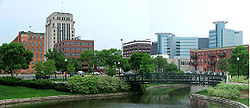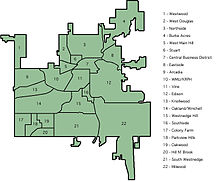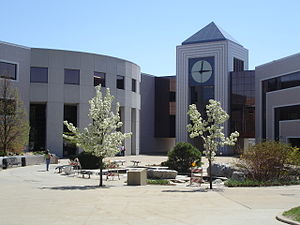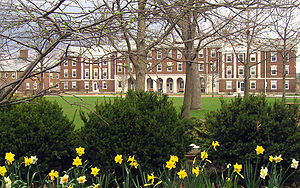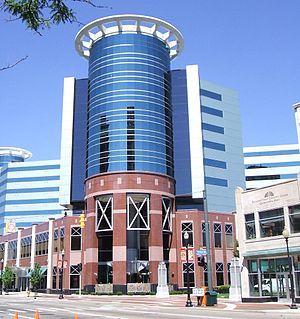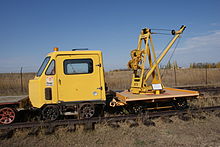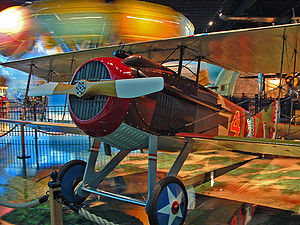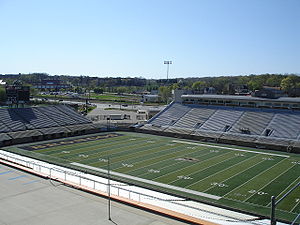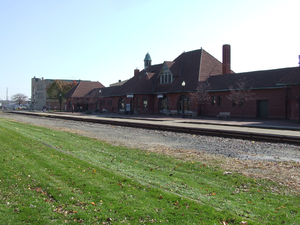- Kalamazoo, Michigan
-
Kalamazoo, Michigan — City — 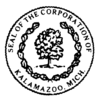
SealNickname(s): The Mall City, K-zoo, The Zoo Location of Kalamazoo within Kalamazoo County, Michigan Coordinates: 42°17′24″N 85°35′24″W / 42.29°N 85.59°WCoordinates: 42°17′24″N 85°35′24″W / 42.29°N 85.59°W Country United States State Michigan County Kalamazoo Settled 1829 Incorporation 1883 Government - Type Commission-Manager - Mayor Bobby J. Hopewell - City Manager Kenneth P. Collard Area - City 25.2 sq mi (65.2 km2) - Land 24.7 sq mi (63.9 km2) - Water 0.5 sq mi (1.3 km2) Elevation 784 ft (239 m) Population (2010) - City 74,262 - Density 3,006.6/sq mi (1,162.2/km2) - Urban 187,961 - Metro 326,589 Demonym Kalamazooan Time zone Eastern (UTC-5) - Summer (DST) Eastern (UTC-4) Area code(s) 269 FIPS code 26-42160[1] GNIS feature ID 0629439[2] Website www.ci.kalamazoo.mi.us Kalamazoo (
 /ˌkæləməˈzuː/) is the largest city in the southwest region of the U.S. state of Michigan. It is the county seat of Kalamazoo County. As of the 2010 census, the city had a total population of 74,262. It is the major city of the Kalamazoo-Portage metropolitan area, which has a population of 326,589 as of 2010.[3]
/ˌkæləməˈzuː/) is the largest city in the southwest region of the U.S. state of Michigan. It is the county seat of Kalamazoo County. As of the 2010 census, the city had a total population of 74,262. It is the major city of the Kalamazoo-Portage metropolitan area, which has a population of 326,589 as of 2010.[3]Kalamazoo is home to Western Michigan University (often abbreviated as "WMU"), a large public university, and Kalamazoo College (often referred to as "K College"), a liberal arts school whose campus abuts WMU's.
Contents
Name origin
Originally known as Bronson, after founder Titus Bronson, in the township of Arcadia, the names were both changed to "Kalamazoo" in 1836 and 1837, respectively.[4] The Kalamazoo name comes from a Potawatomi word, first found in a British report in 1772. However, the Kalamazoo River, which passes through the modern city of Kalamazoo, was located on the route between Détroit and Fort Saint-Joseph (nowadays Niles, Michigan). Canadians (French-speaking), French traders, missionaries, and military personnel were quite familiar with this area during the French era and thereafter. The name for the Kalamazoo River was then known by Canadians and French as La rivière Kikanamaso. The name "Kikanamaso" was also recorded by Father Pierre Potier, a Jesuit missionary for the Huron-Wendats at the Assumption mission (south shore of Détroit), while en route to Fort Saint-Joseph during the fall of 1760.[5]Legend has it that "Ki-ka-ma-sung," meaning "boiling water," referring to a footrace held each fall by local Native Americans, who had to run to the river and back before the pot boiled.[6] Still another theory is that it means "the mirage or reflecting river."[7] Another legend is that the image of "boiling water" referred to fog on the river as seen from the hills above the current downtown. The name was also given to the river that flows almost all the way across the state.
The name, which sounds unusual to English-speaking ears, has become a metonym for exotic places, as in the phrase "from Timbuktu to Kalamazoo". Today, t-shirts are sold in Kalamazoo with the phrase "Yes, there really is a Kalamazoo".[8]
History
Historical populations Census Pop. %± 1850 2,507 — 1860 6,070 142.1% 1870 9,181 51.3% 1880 11,937 30.0% 1890 17,853 49.6% 1900 24,404 36.7% 1910 39,437 61.6% 1920 48,487 22.9% 1930 54,786 13.0% 1940 54,097 −1.3% 1950 57,704 6.7% 1960 82,189 42.4% 1970 85,555 4.1% 1980 79,722 −6.8% 1990 80,277 0.7% 2000 76,145 −5.1% 2010 74,262 −2.5% The area on which the modern city stands was once home to Native Americans of the Hopewell culture, who migrated into the area sometime before the first millennium. Evidence of their early residency remains in the form of a small mound in downtown's Bronson Park. The Hopewell civilization began to decline after the 8th century and was replaced by other groups.[9] The Potawatomi culture lived in the area when the first European explorers arrived.
René-Robert Cavelier, Sieur de La Salle, passed just southeast of the present city in late March 1680. The first Europeans to reside in the area were itinerant fur traders in the late 18th and early 19th century. There are records of several traders wintering in the area, and by the 1820s at least one trading post had been established.[10][11]
During the War of 1812, the British established a smithy and a prison camp in the area.[12]
The 1821 Treaty of Chicago ceded the territory south of the Grand River to the United States federal government. However, the area around present-day Kalamazoo was reserved as the village of Potawatomi Chief Match-E-Be-Nash-She-Wish. Six years later, as a result of the 1827 Treaty of St. Joseph, the tract that became the city was also ceded.
In 1829, Titus Bronson, originally from Connecticut, became the first white settler to build a cabin within the present city limits.[13] He platted the town in 1831 and named it the village of Bronson—not to be confused with the much-smaller Bronson, Michigan, about fifty miles (80 km) to the south-southeast.
Bronson, frequently described as "eccentric" and argumentative, was later run out of town. The village was renamed Kalamazoo in 1836, due in part to Bronson's being fined for stealing a cherry tree.[14] Today, a hospital and a downtown park, among other things, are named for Bronson.
Kalamazoo was legally incorporated as a village in 1838 and as a city in 1883.
On August 27, 1856, Abraham Lincoln spoke at a rally in Bronson Park, promoting the presidential candidacy of John C. Fremont, who was running on the ticket of the new Republican Party. It was Lincoln's only public speech during his only visit to Michigan.
In 1959, the city created the Kalamazoo Mall, the first outdoor pedestrian shopping mall in the United States, by closing part of Burdick Street to auto traffic. The Mall was designed by Victor Gruen, who also designed the country's first enclosed shopping mall, which had opened three years earlier.[15] Two of the mall's four blocks were reopened to auto traffic in 1999 after much debate.[16]
An F3 tornado struck downtown Kalamazoo on May 13, 1980, killing five and injuring 79.[17]
Geography
Most of the city is on the southwest bank of a major bend in the Kalamazoo River, with a small portion, about 2.8 square miles (7.3 km2), on the opposite bank. Several small tributaries of the river, including Arcadia Creek and Portage Creek, wind through the city. The northeastern portion of the city sits in the broad, flat Kalamazoo Valley, while the western portions climb into low hills to the west and south. Several small lakes are found throughout the area.
The city covers 25.2 square miles (65 km2), of which 24.7 square miles (64 km2) is land and 0.5 sq miles (2%) is water, according to the United States Census Bureau.
The city's suburban population is located primarily to the south, in the city of Portage, and to the west in Oshtemo Township and Texas Township, Michigan.
At least part of the municipal water supply for Kalamazoo is provided by the watershed contained within the Al Sabo Preserve[18] in Texas Charter Township, Michigan, immediately southwest of Kalamazoo.
Another watershed, Kleinstuck Marsh,[19] is popular with hikers and birdwatchers. Kleinstuck Marsh is south of Maple Street, between Oakland Drive and Westnedge Avenue, Kalamazoo's major north-south artery.
Demographics
As of the census[1] of 2008, there were 76,145 people, 29,413 households, and 14,353 families residing in the city. The population density was 3,125.4 inhabitants per square mile (1,206.7 /km2). There were 31,798 housing units at an average density of 1,288.2 per square mile (497.5/km²). The racial makeup of the city was 70.77% White, 20.64% Black or African American, 0.58% Native American, 2.39% Asian, 0.06% Pacific Islander, 2.38% from other races, and 3.18% from two or more races. 4.28% of the population were Hispanic or Latino of any race.
There were 29,413 households out of which 24.9% had children under the age of 18 living with them, 30.6% were married couples living together, 14.7% had a female householder with no husband present, and 51.2% were non-families. 34.8% of all households were made up of individuals and 9.6% had someone living alone who was 65 years of age or older. The average household size was 2.30 and the average family size was 2.99.
In the city the population was spread out with 20.3% under the age of 18, 27.6% from 18 to 24, 26.8% from 25 to 44, 15.2% from 45 to 64, and 10.1% who were 65 years of age or older. The median age was 26 years. For every 100 females there were 93.1 males. For every 100 females age 18 and over, there were 89.9 males.
The median income for a household in the city was $31,189, and the median income for a family was $42,438. Males had a median income of $32,160 versus $25,532 for females. The per capita income for the city was $16,897. About 13.6% of families and 24.3% of the population were below the poverty line, including 26.0% of those under age 18 and 11.3% of those age 65 or over.
Government
Kalamazoo government is administered under a Commission-Manager style of government. The City Commission is the representative body of the city, and consists of seven members, elected on a non-partisan basis every two years. Whoever receives the most votes during an election becomes the council president and ceremonial mayor of the city. The member that receives the second highest number of votes becomes vice mayor.[20] The current mayor, Bobby J. Hopewell, was elected November 13, 2007, beating Hannah McKinney, who automatically became vice mayor.[21]
In the November 3, 2009, election voters returned Hopewell as mayor and McKinney as vice-mayor.
The City Manager is the city's chief administrative officer. The manager is hired by, and answers to, the City Commission.
Neighborhoods
The city of Kalamazoo is commonly divided into 22 neighborhoods, many of which are served by a neighborhood association. The Neighborhood Development Division of the city's government works with these associations to invest federal, state, and local funds, including those from the Community Development Block Grant program, in community improvements and economic growth.
Education
Kalamazoo is home to Western Michigan University. The college has four campuses in Kalamazoo, (West Campus, East Campus, Parkview Campus and Oakland Drive Campus) as well as several satellite campuses throughout Michigan. West Campus, located just west of downtown, has the largest concentration of university students, programs and school services. In 2005, Western Michigan ranked #2 Wireless Campus in the U.S. in a national survey done by the Intel Corporation.[22]
Each May, WMU hosts the International Congress on Medieval Studies. Organized by the Medieval Institute's faculty and graduate students, the Congress brings some 3,000 professors and students from around the globe to present and discuss a variety of topics related to the Middle Ages.
Kalamazoo College, a private liberal arts college founded in 1833 is located on a hill opposite WMU's original campus.
Kalamazoo is home to Kalamazoo Valley Community College, Davenport University, and Kalamazoo Area Mathematics and Science Center (KAMSC). It had also been the home of Nazareth College, which closed in 1992.
The public schools are managed by Kalamazoo Public Schools. Every resident graduate of the Kalamazoo Public Schools is provided with a scholarship for up to 100% of tuition and mandatory fee costs for four years at any public university or community college in Michigan, starting with the class of 2006. This program is known as the Kalamazoo Promise. Books and room and board are not included.[23]
Economy
Breweries
Kalamazoo has three local breweries and brewpubs that produce a variety of beer styles.
Perhaps the best-known is Bell's Brewery, established as the Kalamazoo Brewing Company in 1985 by Larry Bell.[24] The brewery has expanded from its original Kalamazoo location, which houses the Eccentric Cafe, to another brewery in nearby Comstock. Bell's beer is sold by retailers in many parts of the country.
Flavorings
The A.M. Todd Company, one of the lead producers of peppermint oil and other flavorings, is headquartered in Kalamazoo.[25] Its founder, Albert M. Todd, was elected to the United States House of Representatives for the 55th Congress.
Kalamazoo is also home to Kalsec, another flavorings company, which was founded by Paul H. Todd, Jr., Albert Todd's grandson and U.S. Representative in the 89th Congress. Founded as the Kalamazoo Spice Extraction Company, Kalsec is owned and managed by Todd family descendants.[26]
Historical
In the past, Kalamazoo was known for its production of windmills, mandolins, buggies, automobiles, cigars, stoves, paper, and paper products. Agriculturally, it once was noted for celery and bedding plants. Although much has become suburbanized, the surrounding area still produces farm crops.
Kalamazoo was the original home of Gibson Guitar Corporation, which spawned the still-local Heritage Guitars. The company was incorporated as "Gibson Mandolin - Guitar Co., Ltd" on October 11, 1902, by the craftsman Orville Gibson. One budget model was named the Gibson Kalamazoo Electric Guitar. Operations were moved gradually from Kalamazoo to Nashville, Tennessee, (Electric Division) and Bozeman, Montana, (Acoustic Division) in the 1980s. Some workers from the original factory stayed in Kalamazoo to create the Heritage Guitar company.[28]
Kalamazoo was once known as the "Paper City" because of the paper mills in and near the city. The Allied Paper Corporation operated several mills and employed 1,300 people in Kalamazoo during the late 1960s. As the forests of West Michigan were logged out, paper mills closed.[29][30]
Early in the 20th century, Kalamazoo was home to the brass era automobile company Barley.
Kalamazoo was also headquarters of the Checker Motors Company, the former manufacturer of the Checker Cab, which also stamped sheet metal parts for other auto manufacturers. Checker closed on June 25, 2009, a victim of the Late-2000s recession.
Life Sciences
The Upjohn Company was a pharmaceutical manufacturing firm founded in 1886 in Kalamazoo that is now part of the Pfizer Corporation. Most of Upjohn's original facilities remain, many have been renovated and some new buildings have been constructed. The bulk of the facilities exist in Portage, Michigan, but many also exist in Downtown Kalamazoo.
Michigan State University has a branch of its medical school and several post-doctoral residency training programs in Kalamazoo. Resident training programs in Pediatrics, Internal Medicine, Combined Internal Medicine/Pediatrics, General Surgery, Family Medicine, Orthopedic surgery, Emergency Medicine, Psychiatry, and a fellowship in sports medicine are centered at The Kalamazoo Center for Medical Studies (KCMS) founded by Michigan State University.
The city is also home to the Stryker Corporation, a surgical and medical devices manufacturer.
Kalamazoo has two hospitals: Bronson Methodist Hospital, and Borgess Medical Center.
Research
The W. E. Upjohn Institute for Employment Research, a nonpartisan, not-for-profit research organization, has operated in Kalamazoo since its establishment in 1945. The Institute conducts research into the causes and effects of unemployment and measures for the alleviation of unemployment. The Institute also publishes Business Outlook for West Michigan,[31] a quarterly journal that provides economic analysis and forecasts on the West Michigan economy.
Other
Other notable Kalamazoo businesses include:
- The Farmers' Market, located on Bank Street, is open on Tuesdays and Saturdays, May through November.
- National City (Kalamazoo was formerly the corporate HQ of First of America Bank, which merged with National City Bank in 1997), National City has since been purchased and merged with PNC Bank which still maintains a large corporate building in Texas Township, and several downtown along with branches in the region.
Culture
The city has an Arts Council.[32] On the first Friday of each month, the council organizes the Art Hop, in which patrons circulate among downtown businesses.
Groups often perform at the downtown State Theatre, Western Michigan University's Miller Auditorium, and Wings Stadium.
The annual "Eccentric Day" at Bell's Eccentric Cafe celebrates the brewery's Eccentric Ale on the December Friday that marks the end of finals at Western Michigan University.[33]
There is no longer a zoo in Kalamazoo. The Milham Park Zoo closed in 1974.
Next to Milham Park is the Milham Park Golf Course.[34] Completed in 1936, the 18-hole, par-72 course is entirely within the city limits of Kalamazoo.
In 2002, the Kalamazoo Public Library was named "Library of the Year" by Library Journal.[35] The library includes a main location and four branch libraries, and until 2010, a bookmobile system.[36]
Animation festival
A project of Kalamazoo Valley Community College, The Kalamazoo Animation Festival International (KAFI) encourages and educates animation artists, promotes Kalamazoo's animation industry, and provides community entertainment.[37] In addition to a biannual festival, KAFI sponsors events such as film screenings and workshops throughout the year.
KAFI's first festival drew 235 submissions and nearly 1,000 attendees in 2002. A second festival was held in 2003. Since then, an every-other-year schedule has been adopted. The 2007 festival attracted more than 500 entries from 37 countries. In addition to an animated film competition with $15,000 in prizes awarded, the festival features events for students, artists, educators, filmmakers and the general public. Past KAFI award winners include Bill Plympton, Chris Landreth and John Canemaker.[citation needed]
Museums
The city's most prominent art museum is the Kalamazoo Institute of Arts, whose collection has more than 3,600 works and a focus on 20th-century American art. The KIA regularly mounts temporary exhibitions.
Downtown is the Kalamazoo Valley Museum, a "hands-on" museum aimed largely at children; it has a planetarium and a Challenger Learning Center.
Northeast of town, in Hickory Corners, is the Gilmore Car Museum, which includes cars used in Walt Disney movies.
The Kalamazoo Air Zoo, just south of town, has several dozen aircraft on display, from biplanes to jets.
Theater
Kalamazoo's theaters and performing groups include the Kalamazoo Civic Players, New Vic Theatre, Farmer's Alley Theatre, Crawlspace Theatre Productions, and the Barn Theatre in nearby Augusta. Plays and musicals are also performed at Kalamazoo College and Western Michigan University.
Music
The Gibson Guitar Corporation, founded in Kalamazoo in 1902, spurred local musicians playing in everything classical to folk, to modern rock. The Kalamazoo Symphony Orchestra,[38] founded in 1921, is directed by Raymond Harvey. The city also hosts the Irving S. Gilmore International Keyboard Festival and a Bach Festival.
The local and indie music scene has produced pop stars such as RCA recording artists The Verve Pipe and Metal Blade recording artists Thought Industry.
Sports
Kalamazoo plays host to four non-collegiate teams:
- The Kalamazoo Kings minor-league baseball team plays games at Homer Stryker Field and is a member of the independent Frontier League.
- The Kalamazoo Wings (aka K-Wings) minor-pro hockey team plays games in Wings Stadium and has played since 1974. The team is currently a member of the ECHL.
- The Kalamazoo Outrage is a soccer club and has men's, women's and junior teams and is a member of United Soccer League. Former USA international team player John Harkes played with the Owls in the 1990s, as well as current international player Frank Simek.
The Western Michigan University Broncos, who compete in the NCAA Division I Mid-American Conference, play at the following on-campus venues:
- Waldo Stadium (football)
- Lawson Arena (hockey)
- University Arena (basketball and Volleyball)
- Hyames Field (baseball)
- Ebert Field (softball)
- Kanley Track (outdoor track and field)
Hyames Field played host to the first two College World Series held in 1947 and 1948. Future U. S. President George H. W. Bush was a first baseman for Yale in the 1947 series.
The Kalamazoo College Hornets and Kalamazoo Valley Community College Cougars also have several collegiate athletic teams.
Kalamazoo is the hometown of New York Yankees all-star shortstop Derek Jeter, Green Bay Packers wide receiver Greg Jennings, and free agent running back T.J. Duckett. Washington Nationals pitcher Scott Olsen and Chicago White Sox first baseman and gold glove winner Mike Squires was born in Kalamazoo. Kalamazoo was also the hometown of longtime Detroit Tigers owner John Fetzer, who owned the American League team from 1961 through 1984, when he sold the franchise to Domino's Pizza founder Tom Monaghan.
The United States Tennis Association Boys 18 and 16 National Tennis Championships are hosted every summer by Kalamazoo College. The event has featured such players as Jimmy Connors, John McEnroe, Jim Courier, Andre Agassi, Pete Sampras, Michael Chang, James Blake and Andy Roddick, before they turned professional.
Local media
Newspapers
Kalamazoo is served by one daily newspaper, the Kalamazoo Gazette.
The main office of Business Review Western Michigan, a business-to-business publication, is located downtown next to the Kalamazoo Gazette.
Located on campus, but completely independent of the university, Western Herald is the morning, weekday, student-run newspaper at Western Michigan University, distributed free of charge on-campus and around the greater Kalamazoo area. Unlike most college newspapers, the Herald is funded entirely by advertising dollars and does not receive any student activity fees or other funding from the university or taxpayers.
The Index is the weekly student newspaper of Kalamazoo College.
Television
WWMT, West Michigan's CBS / CW affiliate, is licensed and operates out of Kalamazoo but serves the entire West Michigan region. The station was originally owned and operated by famous broadcasting pioneer (and former Detroit Tigers owner) John Fetzer, as "WKZO-TV". Along with television, Fetzer introduced Kalamazoo to radio in 1931, when AM 590 WKZO signed on the air. Fezter also created Kalamazoo's first cable television system, then known as Fetzer Cable; it is a predecessor of Kalamazoo's current cable franchise, Charter Communications.
The Public Media Network, located in downtown Kalamazoo, hosts media outlets including Charter cable channels 19, 20, 21, 22, and 95 where daily public access programs are produced and aired to the public.
Kalamazoo is part of the West Michigan television market, which also includes Grand Rapids and Battle Creek. Most channels that serve the entire market are receivable in Kalamazoo, including WWMT, WOOD-TV (NBC), WXMI (Fox), WZPX (Ion) and WLLA (religious). Some channels based in the northern part of the market reach Kalamazoo through a satellite or translator, such as WTLJ Muskegon (religious, through W26BX), WGVU-TV Grand Rapids (PBS, through WGVK), and WXSP-CA Grand Rapids (MyNetworkTV, through WOKZ-CA). WOTV in Battle Creek broadcasts ABC programming for the southern part of the market, including Kalamazoo. Charter offers all West Michigan channels on its system to Kalamazoo subscribers, including WZZM, the ABC affiliate for Grand Rapids and the northern part of the market.
Radio
WIDR is the college student-run, commercial free radio station at Western Michigan University. It is known for playing obscure and rarely heard underground music of all styles as well as some local news and talk. Broadcasting 100 watts on 89.1 FM, WIDR can be heard from about a 20-mile radius from campus.
WMUK is also on Western Michigan University's campus. It hosts many local music programs including jazz and classical performances as well as programming from NPR. WMUK broadcasts 50,000 watts in high definition on 102.1 FM.
WKDS is West Michigan's only high school student-run radio station. The station signed on in 1983 at 89.9 on the FM dial, broadcasting from Loy Norrix High School. The call letters stood for Kalamazoo District Schools (now Kalamazoo Public Schools). For most of its history, WKDS broadcasted only during daytime hours and not at all on the weekend. In Fall of 2004, the station began broadcasting 24 hours a day, 7 days a week in an attempt to prevent an outside organization to take over the time WKDS was off the air. WKDS was part of a county wide Education For Employment program for years. The radio station is still owned by Kalamazoo Public Schools although the EFE program has been discontinued. High School students from around the area continue to operate the station.
FM radio stations which serve Kalamazoo include:
- WAYK 88.3 - Kalamazoo - Christian Top 40
- WIDR 89.1 - Kalamazoo - College/Variety
- WKDS 89.9 - Kalamazoo - High School/Variety
- WCSG 91.3 - Grand Rapids - Christian AC
- WZUU 92.5 - Mattawan/Kalamazoo - Classic Rock
- WBCT 93.7 - Grand Rapids - Country
- WVIC 94.1 - Jackon/Lansing/Battle Creek/Kalamazoo - Alternative Rock
- WTNR 94.5 - Grand Rapids - Country
- WNWN 95.5 - Kalamazoo - Urban Adult Contemporary (translator for AM 1560)
- WLKM-FM 95.9 - Three Rivers - Classic Hits
- WMAX-FM 96.1 - Grand Rapids - Sports
- WKZO-FM 96.5 - Portage/Kalamazoo - News/Talk (CBS) (simulcast of AM 590)
- WGRD 97.9 - Grand Rapids - Rock
- WNWN-FM 98.5 - Battle Creek - Country
- WBCH-FM 100.1 - Hastings - Country
- WQXC 100.9 - Otsego/Kalamazoo - Oldies
- WMUK 102.1 - Kalamazoo - NPR/Classical/Jazz
- WKFR 103.3 - Battle Creek/Kalamazoo - CHR/Top 40
- WBXX 104.9 - Battle Creek - Adult Contemporary
- WOOD-FM 105.7 - Grand Rapids - Adult Contemporary
- WJXQ 106.1 - Jackson/Lansing - Active Rock
- WVFM 106.5 - Kalamazoo - Adult Contemporary
- WBBL 107.3 - Greenville/Grand Rapids - Sports
- WRKR 107.7 - Portage/Kalamazoo - Classic Rock
AM radio stations which serve Kalamazoo include:
- WKZO 590 - Kalamazoo - News/Talk (CBS)
- WAKV 980 - Allegan/Otsego - Adult Standards
- WKMI 1360 - Kalamazoo - Talk (ABC)
- WKPR 1420 - Kalamazoo - Religious (daytime only)
- WNWN 1560 - Portage/Kalamazoo - Urban Adult Contemporary (daytime only; 24 hour FM translator at 95.5)
- WQLR 1660 - Kalamazoo - Sports (FOX)
Radio Stations from Battle Creek, Grand Rapids, and Lansing are also heard in Kalamazoo.
Transportation
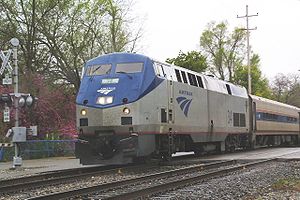 The Wolverine, eastbound, crosses Academy Street in Kalamazoo. The campus of Kalamazoo College lies to the right.
The Wolverine, eastbound, crosses Academy Street in Kalamazoo. The campus of Kalamazoo College lies to the right.
Highways
Interstates
 I-94
I-94 I-94 Business Loop
I-94 Business Loop
U.S. Highways
State Highways
Intercounty Highways
Kalamazoo is served by highways I-94, US 131, M-43 and M-96. It was on the original Territorial Road in Michigan of the 19th century, which started in Detroit and ran to Lake Michigan. Much of that, but not all, later became Old U.S. 12—the "old" designation came about when I-94 was built parallel to it—and also was called Red Arrow Highway after a World War I army division. The name "U.S. 12" was shifted south to what once was U.S. 112 between Detroit and Chicago. Some parts of Old U.S. 12 outside of town, especially in Van Buren County and Berrien County to the west, are still called Red Arrow Highway. The term "Old U.S. 12" has faded from use.
Rail
- Kalamazoo has rail service provided by Amtrak, with the station located downtown and combined with a newly renovated bus terminal.
- Kalamazoo also has a freight service provided by Grand Elk Railroad running north to Grand Rapids, Michigan and south to Elkhart, Indiana. The line they lease was a former Grand Rapids and Indiana Railroad mainline.
Bus
- Bus service to and through the city is provided by Greyhound, Indian Trails and [the kalamazoo trolly].
- Public bus services within the city are provided by Metro Transit.
Air
- On the southern end of the city is the Kalamazoo/Battle Creek International Airport, which offers flights on various airlines to hubs and leisure destinations.
Other
The Kal-Haven Trail, heavily used by cyclists and snowmobilers, extends to downtown Kalamazoo. It runs 34 miles (55 km) between South Haven, Michigan, to a trailhead just west of Kalamazoo. Between that trailhead and South Haven the trail is run by Van Buren County, even the parts within Kalamazoo County. A trail pass is no longer required.
The section east of the trailhead was opened in 2008 and extends to downtown Kalamazoo. It's known as the Kalamazoo River Valley Trail and is run by Kalamazoo County. No pass is required on that section.
Sister cities
The city of Kalamazoo, Michigan has three sister cities.
See also
- People from Kalamazoo, Michigan
- Kalamazoo Department of Public Safety
Notes
- ^ a b "American FactFinder". United States Census Bureau. http://factfinder.census.gov. Retrieved 2008-01-31.
- ^ "US Board on Geographic Names". United States Geological Survey. 2007-10-25. http://geonames.usgs.gov. Retrieved 2008-01-31.
- ^ Table 1. Annual Estimates of the Population of Metropolitan and Micropolitan Statistical Areas: April 1, 2000 to July 1, 2008
- ^ [Living in Kalamazoo, Balls & Lassfalk, 1958]
- ^ Potier, Pierre. 1996. Les écrits de pierre potier, ed. Robert Toupin. Ottawa, ON, CAN: University of Ottawa Press. http://site.ebrary.com.ezproxy.uwindsor.ca/lib/oculwindsor/docDetail.action?docID=10134969
- ^ [Kalamazoo and how it Grew...and Grew, Dunbar, 1959]
- ^ Romig, Walter (1986). Michigan Place Names. Walter Romig. p. 297.
- ^ "Yes, there really is a Kalamazoo" t-shirt, at Kalamazoo Chamber of Commerce.
- ^ Dunbar, Willis (1995). Michigan: A History of the Wolverine State. Grand Rapids, MI: Wm. B. Edermans. pp. 10–12. ISBN 0802870554.
- ^ "Michigan Centennial History". Archived from the original on 2007-11-14. http://web.archive.org/web/20071114084915/http://www.rootsweb.com/~mikalama/centhist1.htm. Retrieved 2007-06-07.
- ^ "Kalamazoo's First Residents: Our Native Americans". Kalamazoo Public Library: Local history. http://www.kpl.gov/collections/localhistory/allabout/general/Indians.aspx. Retrieved 2007-06-07.
- ^ "Michigan Centennial History". Archived from the original on 2007-11-14. http://web.archive.org/web/20071114084915/http://www.rootsweb.com/~mikalama/centhist1.htm. Retrieved 2007-06-07.
- ^ "Titus Bronson: Founder of Kalamazoo". Kalamazoo Public Library: Local history. http://www.kpl.gov/collections/LocalHistory/AllAbout/biography/TitusBronson.aspx. Retrieved 2006-06-20.
- ^ "The History of Kalamazoo MI". Living in Kalamazoo. http://www.kalamazoomi.com/hisf.htm. Retrieved 2006-06-20.
- ^ http://changeobserver.designobserver.com/entry.html?entry=11747
- ^ History of Kalamazoo.
- ^ "Kalamazoo 1980 Tornado". Kalamazoo County, Michigan, Genealogy and Local History. Archived from the original on 2007-02-19. http://web.archive.org/web/20070219071551/http://www.rootsweb.com/~mikalama/tornado.htm. Retrieved 2006-07-30.
- ^ Al Sabo Preserve
- ^ Marsh
- ^ "City Commission". City of Kalamazoo. http://www.kalamazoocity.org/portal/government.php?page_id=33. Retrieved 2007-07-07.
- ^ "Hopewell sworn in as Kalamazoo mayor - News". Western Herald. http://media.www.westernherald.com/media/storage/paper881/news/2007/11/14/News/Hopewell.Sworn.In.As.Kalamazoo.Mayor-3099072.shtml. Retrieved 2007-12-08.
- ^ "Intel Most Unwired College Challenge". http://www.intel.com/pressroom/archive/releases/2005/20051011corp.htm. Retrieved 2010-06-13.
- ^ "Affordable College for All". CBS, Katie Couric. http://www.youtube.com/watch?v=5nYI9FMz-sU. Retrieved 2007-02-07. To receive any assistance, a student must live within the Kalamazoo Public School District boundaries and would have had to attend since at least ninth grade. Sixty-five percent of that student's tuition would be paid. The scale goes up from there, with eighth graders receiving 70 percent of their tuition paid, 75 percent for seventh graders, 80 percent for sixth, 85 percent for fifth, 90 percent for fourth, and 95 for first through third graders. Resident students attending schools in the district from kindergarten through high school graduation will have 100 percent of their tuition and fees paid.
- ^ Bell's Brewery/
- ^ http://www.amtbotanicals.com/
- ^ Kalsec
- ^ "Welcome to Saskrailmuseum.org". Contact Us. September 11, 2008. http://www.saskrailmuseum.org/. Retrieved 2008-10-03.
- ^ Heritage Guitar Inc
- ^ "Paper Industry Provides 25% of City's Employment", Kalamazoo News, 18 July 1940
- ^ "This is Still the Paper City", Al Jones, Kalamazoo Gazette, 14 March 1999
- ^ West Michigan Data Center/Business Outlook
- ^ Kalamazoo Arts Council
- ^ Eccentric Ale Day
- ^ Milham Park golf course
- ^ [1]
- ^ Kalamazoo Public Library
- ^ Kalamazoo Animation Festival International
- ^ [2]
External links

Grand Rapids 
Benton Harbor 
Battle Creek  Kalamazoo
Kalamazoo 

Three Rivers Image=Flag of Michigan.svg
Municipalities and communities of Kalamazoo County, Michigan County seat: Kalamazoo Cities Villages Augusta | Climax | Richland | Schoolcraft | Vicksburg
Charter
townshipsGeneral law
townshipsAlamo | Brady | Charleston | Climax | Pavilion | Prairie Ronde | Richland | Ross | Schoolcraft | Wakeshma
Unincorporated
communitiesComstock Northwest | Eastwood | Greater Galesburg | Scotts | South Gull Lake | Westwood
Categories:- Kalamazoo, Michigan
- Cities in Michigan
- County seats in Michigan
- Populated places in Kalamazoo County, Michigan
- University towns in the United States
- Populated places established in 1831
Wikimedia Foundation. 2010.

